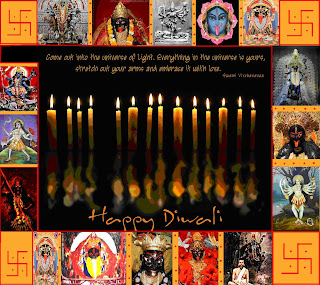For Hindu Business Communities , still Diwali aushers a new year of book keeping with new set of Books .
Why do we celebrate Diwali? It’s not just the festive mood in the air that makes you happy, or just that it's a good time to enjoy before the advent of winter. There are 10 mythical and historical reasons why Diwali is a great time to celebrate. And there are good reasons not just for Hindus but also for all others to celebrate this great Festival of Lights.
- Mythical Ma Kali In Bengal the festival is dedicated to the worship of Kali. Kali is the fearful and ferocious form of the mother goddess. She assumed the form of a powerful goddess and became popular with the composition of the Devi Mahatmya, a text of the 5th - 6th century AD. Here she is depicted as having born from the brow of Goddess Durga during one of her battles with the evil forces. As the legend goes, in the battle, Kali was so much involved in the killing spree that she got carried away and began destroying everything in sight. To stop her, Lord Shiva threw himself under her feet. Shocked at this sight, Kali stuck out her tongue in astonishment, and put an end to her homicidal rampage. Hence the common image of Kali shows her in her mêlée mood, standing with one foot on Shiva's chest, with her enormous tongue stuck out.
- Mahanirvana Tantra says : "Just as all colors disappear in black, so all names and forms disappear in her". Her nudity is primeval, fundamental, and transparent like Nature — the earth, sea, and sky. Kali is free from the illusory covering, for she is beyond the all maya or "false consciousness." Kali's garland of fifty human heads that stands for the fifty letters in the Sanskrit alphabet, symbolizes infinite knowledge.
- Her three eyes represent past, present, and future, — the three modes of time — an attribute that lies in the very name Kali ('Kala' in Sanskrit means time). The eminent translator of Tantrik texts, Sir John Woodroffe in Garland of Letters, writes, "Kali is so called because She devours Kala (Time) and then resumes Her own dark formlessness." Her girdle of severed human hands signifies work and liberation from the cycle of karma. Her white teeth show her inner purity, and her red lolling tongue indicates her omnivorous nature — "her indiscriminate enjoyment of all the world's 'flavors'." Her sword is the destroyer of false consciousness and the eight bonds that bind us.
- Kali's proximity to cremation grounds where the five elements or "Pancha Mahabhuta" come together, and all worldly attachments are absolved, again point to the cycle of birth and death. The reclined Shiva lying prostrate under the feet of Kali suggests that without the power of Kali (Shakti), Shiva is inert.
- Kali's guises and names are diverse. Shyama, Adya Ma, Tara Ma and Dakshina Kalika, Chamundi are popular forms. Then there is Bhadra Kali, who is gentle, Shyamashana Kali, who lives only in the cremation ground, and so on. The most notable Kali temples are in Eastern India — Dakshineshwar and Kalighat in Kolkata (Calcutta) and Kamakhya in Assam, a seat of tantrik practices. Ramakrishna Paramhamsa, Swami Vivekananda, Vamakhyapa, and Ramprasad are some of the legendary devotees of Kali. One thing was common to these saints — all of them loved the goddess as intimately as they loved their own mother.
Diwali or Deepawali also carries significance for different communities for varies auspicious mythical history.
Here is the auspicious list
- Goddess Lakshmi’s Birthday: The Goddess of wealth, Lakshmi incarnated on the new moon day (amaavasyaa) of the Kartik month during the churning of the ocean (samudra-manthan), hence the association of Diwali with Lakshmi.
- Vishnu Rescued Lakshmi: On this very day (Diwali day), Lord Vishnu in his fifth incarnation as Vaman-avtaara rescued Lakshmi from the prison of King Bali and this is another reason of worshipping Ma Larkshmi on Diwali.
- Krishna Killed Narakaasur: On the day preceding Diwali, Lord Krishna killed the demon king Narakaasur and rescued 16,000 women from his captivity. The celebration of this freedom went on for two days including the Diwali day as a victory festival.
- The Return of the Pandavas: According to the great epic ‘Mahabharata’, it was ‘Kartik Amavashya’ when the Pandavas appeared from their 12 years of banishment as a result of their defeat in the hands of the Kauravas at the game of dice (gambling). The subjects who loved the Pandavas celebrated the day by lighting the earthen lamps.
- The Victory of Rama: According to the epic ‘Ramayana’, it was the new moon day of Kartik when Lord Ram, Ma Sita and Lakshman returned to Ayodhya after vanquishing Ravana and conquering Lanka. The citizens of Ayodhya decorated the entire city with the earthen lamps and illuminated it like never before.
- Coronation of Vikramaditya: One of the greatest Hindu King Vikramaditya was coroneted on the Diwali day, hence Diwali became a historical event as well.
- Special Day for the Jains: Mahavir Tirthankar, considered to be the founder of modern Jainism also attained his nirvana on Diwali day.
- The rituals vary according to region. However, special blessings are given to Laxshmi, the Goddess of wealth and prosperity, and Ganesha, the remover of obstacles. The Goddess Laxshmi is believed to have been created from the churning of the ocean on the main Diwali day, and that she'll visit every home during the Diwali period, bringing with her prosperity and good fortune. It’s said that she visits the cleanest houses first, therefore people make sure their houses are spotless before lighting lamps to invite her in. Small statues of the Goddess are also worshiped in people’s homes.
- Some celebrate the marriage of Lakshmi with Lord Vishnu.
.
